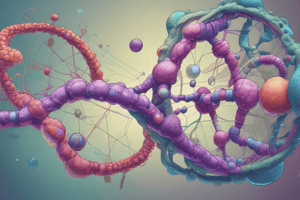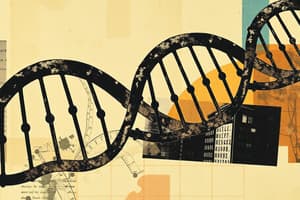Podcast
Questions and Answers
What is the significance of microbial diversity in ecosystems?
What is the significance of microbial diversity in ecosystems?
- It has no considerable impact on the ecosystem.
- It solely benefits human health.
- It contributes to ecological balance and nutrient cycling. (correct)
- It increases competition among large animals.
Which mechanism of evolution involves a random change in allele frequencies within a population?
Which mechanism of evolution involves a random change in allele frequencies within a population?
- Natural selection
- Genetic drift (correct)
- Speciation
- Gene flow
What is the primary role of microorganisms in soil ecology?
What is the primary role of microorganisms in soil ecology?
- To facilitate decomposition and nutrient cycling. (correct)
- To inhibit the growth of beneficial fungi.
- To compete with plants for nutrients.
- To solely cause diseases in larger organisms.
What does phylogeny help to illustrate in evolutionary biology?
What does phylogeny help to illustrate in evolutionary biology?
Which process describes the survival and reproductive success of organisms that are best adapted to their environment?
Which process describes the survival and reproductive success of organisms that are best adapted to their environment?
What distinguishes eukaryotic cells from prokaryotic cells?
What distinguishes eukaryotic cells from prokaryotic cells?
Which statement best describes the role of mitochondria in a cell?
Which statement best describes the role of mitochondria in a cell?
What is a key feature of Mendelian genetics?
What is a key feature of Mendelian genetics?
What is the primary role of ribosomes in a cell?
What is the primary role of ribosomes in a cell?
Which process describes the flow of genetic information outlined in the central dogma of molecular biology?
Which process describes the flow of genetic information outlined in the central dogma of molecular biology?
Which ecological concept studies the interactions among different species within a community?
Which ecological concept studies the interactions among different species within a community?
How do genetic mutations contribute to evolution?
How do genetic mutations contribute to evolution?
Why is biodiversity important for ecosystem stability?
Why is biodiversity important for ecosystem stability?
Flashcards
Microbiology study
Microbiology study
The study of microscopic living things like bacteria, viruses, and fungi.
Evolutionary processes
Evolutionary processes
Changes in living things over time driven by natural selection.
Natural selection
Natural selection
A key driver of evolution where traits that help survival are more likely to be passed on.
Microbial diversity
Microbial diversity
Signup and view all the flashcards
Phylogenetic trees
Phylogenetic trees
Signup and view all the flashcards
Prokaryotic Cell
Prokaryotic Cell
Signup and view all the flashcards
Eukaryotic Cell
Eukaryotic Cell
Signup and view all the flashcards
Cell Membrane
Cell Membrane
Signup and view all the flashcards
Cellular Respiration
Cellular Respiration
Signup and view all the flashcards
Gene
Gene
Signup and view all the flashcards
DNA Replication
DNA Replication
Signup and view all the flashcards
Ecosystem Ecology
Ecosystem Ecology
Signup and view all the flashcards
Biodiversity
Biodiversity
Signup and view all the flashcards
Study Notes
Cell Biology
- Cells are the fundamental units of life, exhibiting diverse structures and functions.
- Prokaryotic cells (e.g., bacteria) lack a nucleus and membrane-bound organelles, while eukaryotic cells (e.g., animal and plant cells) possess these features.
- Cell membranes regulate the passage of substances into and out of the cell.
- Cellular respiration generates energy in the form of ATP.
- Protein synthesis involves transcription and translation.
- Cell signaling pathways transmit information within and between cells.
- Mitosis and meiosis are processes essential for cell division and reproduction.
- Cell structures like mitochondria (energy production) and ribosomes (protein synthesis) play critical roles in cellular processes.
- Cytoskeletal elements maintain cell shape and facilitate intracellular transport.
Genetics
- Genes are segments of DNA that code for proteins, carrying hereditary information.
- DNA replication ensures accurate transmission of genetic material.
- DNA is the molecule of heredity in most organisms.
- Central dogma of molecular biology describes the flow of genetic information.
- Mendelian genetics explains patterns of inheritance using principles of dominance, segregation, and independent assortment.
- Chromosomes carry genes and are organized structures in cells.
- Mutations are changes in DNA sequences that can lead to phenotypic variation.
- Genetic variations underlie evolution and adaptation.
- Molecular mechanisms of gene expression regulate the production of proteins.
- Gene regulation plays a crucial role in cellular processes.
Ecology
- Ecology studies the relationships between organisms and their environment.
- Biomes are large-scale communities of organisms characterized by specific climate and vegetation.
- Food webs illustrate energy flow and trophic interactions within ecosystems.
- Population dynamics examines factors affecting population growth and size.
- Community ecology studies interactions among different species in a community.
- Ecosystem ecology encompasses energy flow, nutrient cycling, and biotic-abiotic interactions.
- Biodiversity is crucial for ecosystem stability and productivity.
- Conservation biology focuses on protecting and restoring biodiversity.
- Biogeochemical cycles describe the movement of elements through living and non-living parts of ecosystems.
- Human impact on ecosystems and its consequences
Microbiology
- Microbiology encompasses the study of microorganisms, including bacteria, viruses, fungi, and protists.
- Microorganisms play crucial roles in various processes, including decomposition and nutrient cycling.
- Microbial diversity is vast and impacts numerous ecosystems.
- Microbial interactions, both beneficial and detrimental, are crucial to ecological balance.
- Techniques like microscopy and culturing are used to study microorganisms.
- Infection and immunity, including the immune response.
- Microbial diseases and their treatments.
- Microbial genetics and evolution.
- Industrial applications of microorganisms, like in biotechnology and food production.
- Microbial ecology in specific environments, such as soil or water.
Evolutionary Biology
- Evolutionary biology studies the processes that have shaped the diversity of life on Earth over time.
- Natural selection is a key mechanism in evolution, driving adaptation.
- Phylogeny traces the evolutionary relationships between organisms.
- Speciation describes the formation of new species.
- Evolutionary history is reflected in similarities and differences among organisms.
- Fossil records provide valuable information on past life forms.
- Adaptation to changing environments promotes survival and reproductive success.
- Modern synthesis integrates Mendelian genetics with Darwinian evolution.
- Phylogenetic trees depict evolutionary relationships.
- Mechanisms of evolution like genetic drift and gene flow influence populations.
Studying That Suits You
Use AI to generate personalized quizzes and flashcards to suit your learning preferences.




